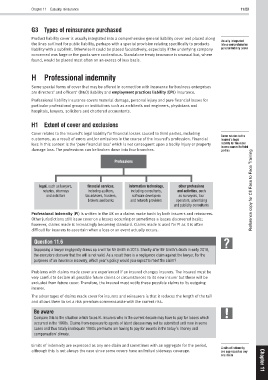Page 313 - M97TB9_2018-19_[low-res]_F2F_Neat2
P. 313
Chapter 11 Casualty reinsurance 11/23
G3 Types of reinsurance purchased
Product liability cover is usually integrated into a comprehensive general liability cover and placed along
Usually integrated
the lines outlined for public liability, perhaps with a special provision relating specifically to products into a comprehensive
liability with a sublimit. Otherwise it could be placed facultatively, especially if the underlying company general liability cover
concerned was large or the goods were contentious. Standalone treaty insurance is unusual but, where
found, would be placed most often on an excess of loss basis.
H Professional indemnity
Some special forms of cover that may be offered in connection with insurance for business enterprises
are directors’ and officers’ (D&O) liability and employment practices liability (EPL) insurance.
Professional liability insurance covers material damage, personal injury and pure financial losses for
particular professional groups or institutions such as architects and engineers, physicians and
hospitals, lawyers, solicitors and chartered accountants.
H1 Extent of cover and exclusions
Cover relates to the insured’s legal liability for financial losses caused to third parties, including
Cover relates to the
customers, as a result of errors and/or omissions in the course of the insured’s profession. Financial insured’s legal
loss in this context is the ‘pure financial loss’ which is not consequent upon a bodily injury or property liability for financial
losses caused to third
damage loss. The professions can be broken down into four branches. parties
Professions
legal, such as lawyers, financial services, information technology, other professions
notaries, attorneys including auditors, including consultants, and activities, such Reference copy for CII Face to Face Training
and solicitors tax advisers, trustees, software developers as surveyors, tour
brokers and banks and network providers operators, advertising
and publicity consultants
Professional indemnity (PI) is written in the UK on a claims made basis by both insurers and reinsurers.
Other jurisdictions still issue cover on a losses occurring or sometimes a losses discovered basis;
however, claims made is increasingly becoming standard. Claims made is used for PI as it is often
difficult for insurers to ascertain when a loss or an event actually occurs.
Question 11.6
Supposing a lawyer negligently draws up a will for Mr Smith in 2013. Shortly after Mr Smith’s death in early 2018,
the executors discover that the will is not valid. As a result there is a negligence claim against the lawyer. For the
purposes of an insurance recovery, which year’s policy would you expect to meet the claim?
Problems with claims made cover are experienced if an insured changes insurers. The insured must be
very careful to declare all possible future claims or circumstances to its new insurer but these will be
excluded from future cover. Therefore, the insured must notify these possible claims to its outgoing
insurer.
The advantages of claims made cover for insurers and reinsurers is that it reduces the length of the tail
and allows them to set a risk premium commensurate with the current risk.
Be aware
Compare this to the situation which faces EL insurers who in the current decade may have to pay for losses which
occurred in the 1960s. Claims from exposure to agents of latent disease may not be submitted until now in some
cases and thus totally inadequate 1960s premiums are having to pay for awards in the today’s ‘money and
compensation’ climate.
Limits of indemnity are expressed as any one claim and sometimes with an aggregate for the period,
Limits of indemnity
although this is not always the case since some covers have unlimited sideways coverage. are expressed as any
one claim Chapter
11

